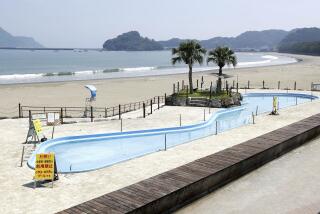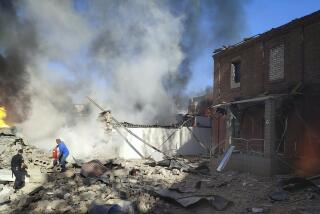Japan nuclear crisis ebbing, U.S. experts say
- Share via
Although the damaged Fukushima Daiichi nuclear power plant has not yet been stabilized, there is no evidence that overheating during the last month has resulted in any melting of the reactor vessels or their containment structures, Obama administration officials said Thursday.
If that assessment is correct, then significant additional releases of radioactivity into the environment will be limited, and emergency crews should have a far better chance of preventing further damage to the plant’s reactors.
The assessment, provided to The Times on background, suggests that the plant is unlikely to suffer a complete meltdown, in which uranium fuel gets so hot that it melts through the bottom of the reactor and containment vessels, spewing high-level radiation into the plant’s underlying foundation.
“We are a long way from a point where anybody would say this is stable,” a senior administration official said. “But it is not a runaway. For a long time, we will be at a declining level of risk.”
The conclusions by Obama administration experts appear more optimistic about the outcome at Fukushima than recent reports that have leaked out of the Nuclear Regulatory Commission, which have suggested that the situation is increasingly risky and dangerous.
Separately, the staff of the NRC came under heavy questioning Thursday by the Advisory Committee on Reactor Safeguards, a panel of outside experts, academics and nuclear industry officials that provides guidance to the agency.
At a committee meeting, NRC officials were asked about the scientific basis for their agency’s advice that Americans evacuate a 50-mile zone around the plant. NRC officials said they couldn’t provide an explanation and would have to get back to the committee.
NRC officials were unavailable for comment afterward.
Meanwhile, northern Japan was rattled by a 7.1 aftershock, the strongest since March 11, when the magnitude 9 earthquake and tsunami struck the region and set in motion the nuclear disaster at Fukushima.
Authorities blamed two deaths on Thursday’s 11:30 p.m. earthquake, which triggered a new tsunami warning that was later canceled. A 79-year-old man died of shock, and a woman in her 60s perished when a power failure turned off her oxygen tank, Japanese media reports said. More than 130 people were injured, police said.
The operator of the battered nuclear plant said there were no indications that the aftershock caused any new problems or injuries there.
The information filtering out of Japan increasingly appears to be setting a boundary for the severity of the problem at Fukushima — though no doubt it is going to take years, if not decades, to remediate the damage already caused.
The most telling evidence about the condition of the reactors is the absence of heavy radionuclide contamination around the plant, which would indicate that uranium fuel became so overheated that it vaporized heavy fission products such as strontium and technetium, experts said.
Instead, the main contaminants have been isotopes of iodine and cesium, which are water soluble and are not held in the uranium fuel itself.
The Obama administration experts said it appears that three reactors could be leaking radioactive water and other contaminants into areas of the plant that should be free from radioactivity, although the cause of breaches is not yet known.
“We don’t know how the containment failed,” one expert said. “It is more of a leak than a massive rupture. There is an extremely low probability of a melt-through of the reactor vessel. There is no conclusive evidence of a melt-through.”
Temperature gauges at the bottom of the reactor vessel recorded levels of 300 degrees Celsius, far below the 1,500-degree melting point of steel. Even if that level were reached, the experts said they are confident that water in the containment structure would have prevented any melt.
Instead of a melt-through, the experts said the leakage from the reactors might be coming through various pieces of equipment that enter the heavy-gauge steel reactor vessel, including mechanical systems that operate control rods or pipes.
Times staff writer John M. Glionna in Tokyo contributed to this report.
More to Read
Sign up for Essential California
The most important California stories and recommendations in your inbox every morning.
You may occasionally receive promotional content from the Los Angeles Times.














